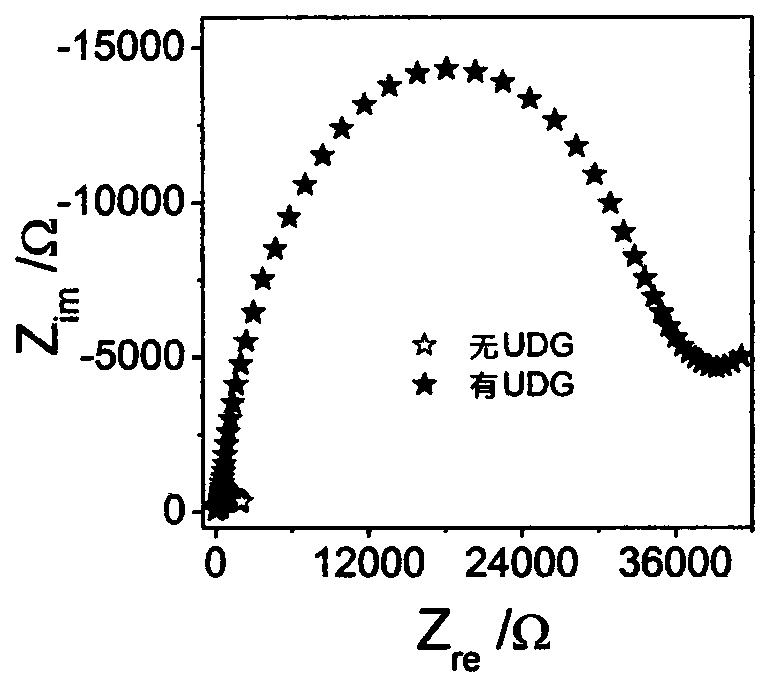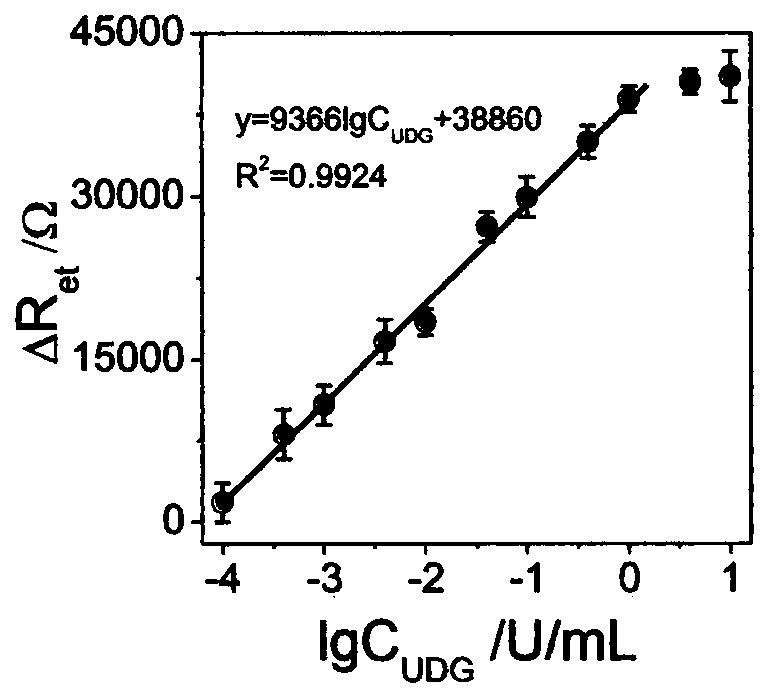Electrochemical method for detecting activity of uracil-DNA glycosylase based on DNA NANOTREE
A glycosylase activity, electrochemical technology, applied in the field of functional biomaterials and biosensing, can solve the problems of electrode interface electron transfer barrier, electrochemical impedance signal amplification, etc., achieve good application prospects, easy operation, accurate results Effect
- Summary
- Abstract
- Description
- Claims
- Application Information
AI Technical Summary
Problems solved by technology
Method used
Image
Examples
Embodiment 1
[0027] The preparation of embodiment 1 sensor
[0028] (1) Au: Put the bare gold electrode on the polishing cloth (containing Al with a particle size of 0.05 μm 2 o 3 suspension) and polished in water for 5 min, then buffered and washed three times with distilled water to obtain Au.
[0029] (2) Electrode 1:
[0030] ① Drop H0 (5 μL, 0.05 μM) onto the electrode surface, assemble overnight, and wash slowly with distilled water. Then soak the electrode in mercaptohexanol (MCH) (1mM) aqueous solution to assemble to seal the unassembled area on the surface of the gold electrode to reduce non-specific adsorption of other biomolecules, and wash slowly with distilled water; ② Prepare 2.5 μL UDG reaction system (UDG reaction buffer, 0.05μM DNA1 and 1U / mL UDG, incubate at 37°C for 1h), then modify the reaction solution on the above-mentioned ① electrode, incubate at 37°C for 30min, wash slowly with distilled water; ③Prepare HCR reaction solution: 1μL 10×Tris reaction buffer, hairpi...
Embodiment 2
[0036] Example 2 UDG activity detection
[0037] In the process of preparing the sensor, in order to study whether the sensor can be applied to the detection of UDG activity, the electrochemical impedance response of the sensor prepared with and without UDG was studied during the sensor preparation process. The results are as follows: figure 2 , proving that the sensor can be used to detect UDG activity.
[0038] Subsequently, during the sensor preparation process, different concentrations of UDG (0, 0.0001, 0.0004, 0.001, 0.004, 0.01, 0.04, 0.1, 0.4, 1, 4, 10 U / mL) were added to detect the electrochemical impedance of the prepared sensor response, the result is as image 3 , between 0.0001~4U / mL, there is a good linear relationship between the AC impedance intensity and the logarithm of the UDG concentration, and the linear equation is y=9366lgC UDG +38860,R 2 =0.9924, the detection limit is 0.00003U / mL, which shows that the sensor can realize highly sensitive detection o...
Embodiment 3
[0039] Example 3 Detection of UDG inhibitor UGI
[0040] In order to prove that the established method can be used for the screening of UDG inhibitors, the UGI model was selected, Figure 4 Described are the AC impedance response curves of the sensor with different UGI concentrations (0, 0.0001, 0.001, 0.01, 0.1, 0.5, 1, 1.5, 2U / mL). As shown in the figure, as the concentration of UGI increases, the electrochemical signal gradually weakens. When the concentration of UGI (1U / mL) is equivalent to that of UDG (1U / mL), the electrochemical impedance signal reaches a plateau, which indicates that the activity of UDG is suppressed by UGI. Effective suppression. From the above experimental results, it can be speculated that the analytical method we established has potential application value for screening UDG inhibitors.
PUM
 Login to View More
Login to View More Abstract
Description
Claims
Application Information
 Login to View More
Login to View More - R&D
- Intellectual Property
- Life Sciences
- Materials
- Tech Scout
- Unparalleled Data Quality
- Higher Quality Content
- 60% Fewer Hallucinations
Browse by: Latest US Patents, China's latest patents, Technical Efficacy Thesaurus, Application Domain, Technology Topic, Popular Technical Reports.
© 2025 PatSnap. All rights reserved.Legal|Privacy policy|Modern Slavery Act Transparency Statement|Sitemap|About US| Contact US: help@patsnap.com



